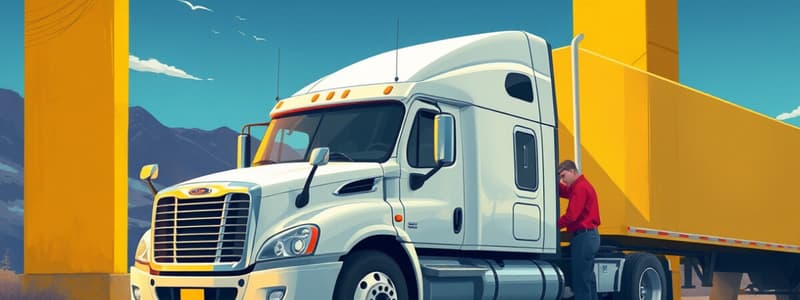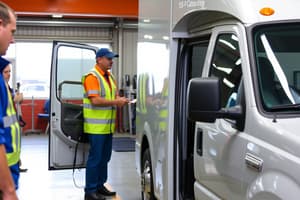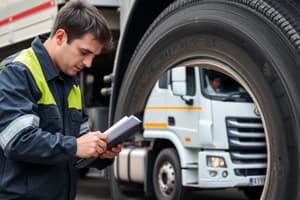Podcast
Questions and Answers
What is the most important reason for doing a vehicle inspection?
What is the most important reason for doing a vehicle inspection?
Safety is the most important reason for completing a vehicle inspection.
What are some things you should check during a trip?
What are some things you should check during a trip?
Watch gauges for signs of trouble, use senses to check for problems, check tires, wheels, brakes, lights, trailer connections, and cargo securement.
What is the minimum tread depth for front tires and for other tires?
What is the minimum tread depth for front tires and for other tires?
At least 4/32 inch tread depth for front tires and 2/32 inch for all other tires.
Name some key steering wheel parts.
Name some key steering wheel parts.
Name some key suspension system defects.
Name some key suspension system defects.
What are three kinds of emergency equipment you must have?
What are three kinds of emergency equipment you must have?
Name some things you should check on the front of your vehicle during the walk-around inspection.
Name some things you should check on the front of your vehicle during the walk-around inspection.
What should wheel bearing seals be checked for?
What should wheel bearing seals be checked for?
How many reflective triangles should you carry?
How many reflective triangles should you carry?
How do you test hydraulic brakes for leaks?
How do you test hydraulic brakes for leaks?
Why put the starter switch key in your pocket during the pre-trip inspection?
Why put the starter switch key in your pocket during the pre-trip inspection?
Why should you back toward the driver side?
Why should you back toward the driver side?
If stopped on a hill, how can you start moving without rolling back?
If stopped on a hill, how can you start moving without rolling back?
When backing, why is it important to use a helper?
When backing, why is it important to use a helper?
What's the most important hand signal that you and the helper should agree on?
What's the most important hand signal that you and the helper should agree on?
What are two special conditions where you should downshift?
What are two special conditions where you should downshift?
When should you downshift with automatic transmissions?
When should you downshift with automatic transmissions?
Retarders keep you from skidding when the road is slippery.
Retarders keep you from skidding when the road is slippery.
Flashcards are hidden until you start studying
Study Notes
Vehicle Inspection Importance
- Safety is the primary reason for conducting vehicle inspections.
- Identifying defects early can prevent breakdowns or accidents.
Trip Checkpoints
- Monitor gauges for operational issues.
- Utilize senses to detect problems.
- Inspect critical components during stops:
- Tires, wheels, and rims
- Brakes
- Lights and reflectors
- Brake and electrical connections to trailer
- Trailer couplings
- Cargo securement devices
Tire Tread Depth
- Minimum tread depth for front tires: 4/32 inch.
- Minimum tread depth for other tires: 2/32 inch.
Key Steering Wheel Components
- Components include:
- Steering wheel
- Steering wheel shaft
- Tie rod
- Steering arms
- Spindle
- Steering ring knuckle
- Drag link
- Pitman arm
- Steering gear box
Suspension System Defects
- Critical for supporting the vehicle and load.
- Common defects to check:
- Broken or cracked spring hangers
- Missing or broken leaf springs
- Leaking shock absorbers
- Damaged air suspension systems
- Cracked or missing frame members
Required Emergency Equipment
- Fire extinguishers
- Spare electrical fuses (if not circuit breaker equipped)
- Warning devices (e.g., 3 reflective warning triangles)
Pre-Trip Inspection of Front Vehicle
- Perform a walk-around inspection.
- Clean lights, reflectors, and glass.
Wheel Bearing Seals
- Ensure they are not leaking.
Reflective Triangles
- Maintain a supply of three reflective warning triangles.
Testing Hydraulic Brakes
- Pump brake pedal three times, maintain firm pressure for five seconds; pedal should not move.
Pre-Trip Safety
- Keep starter switch key in pocket to prevent unauthorized movement of the vehicle.
Backing Technique
- Back towards the driver’s side for better visibility.
Hill Start Strategy
- Partially engage the clutch before releasing the brake to prevent rollback.
- Use parking brake if needed until sufficient engine power is available.
Role of a Helper
- Utilize a helper when backing to mitigate blind spots.
Hand Signals
- Agreement on hand signals is crucial, particularly the signal to stop.
Downshifting Conditions
- Downshift before descending a hill and before entering a curve.
Automatic Transmission Downshifting
- Downshift when traveling downhill to maintain control.
Retarder Functionality
- Retarders do not prevent skidding but assist in slowing the vehicle.
- Types of retarders: exhaust, engine, hydraulic, electric.
- Retarders engage braking power when the accelerator is released.
Studying That Suits You
Use AI to generate personalized quizzes and flashcards to suit your learning preferences.




